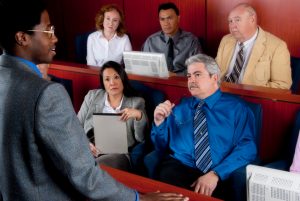Browsing the Intricacies of Test Presentations: Tips for Seamless Delivery and Engaging Disagreements
In the world of legal procedures, the art of trial discussion stands as an important factor of success. The complexities inherent in trial presentations require a fragile balance of finesse, ability, and method.

Recognizing Test Objectives
To efficiently browse a trial, it is critical to have a clear understanding of the purposes that require to be accomplished. Prior to entering the courtroom, lawful groups need to specify their objectives and wanted outcomes. These goals function as assisting principles throughout the test, forming methods and influencing decision-making procedures.
Comprehending test objectives entails a thorough analysis of the case, legal precedents, and the customer's best interests. Trial Presentations. It calls for a thorough assessment of the truths, determining vital problems, and expecting prospective obstacles. By setting details and measurable objectives, attorneys can customize their discussions and arguments to line up with the preferred results
Moreover, a clear understanding of test goals makes it possible for legal teams to prioritize evidence, witnesses, and legal debates efficiently. It permits the growth of a meaningful narrative that reverberates with the discretionary, enhancing the total situation presentation.

Organizing Evidence Properly
Having a clear understanding of test purposes lays the foundation for organizing proof successfully in lawful process - Trial Presentations. By aligning the presentation of proof with the wanted end results of the test, lawful teams can strengthen their arguments and improve their persuasiveness. One critical aspect of arranging proof is classification. Grouping evidence based on styles or significance to specific lawful aspects can help streamline the presentation and make intricate info a lot more digestible for the court or jury.
An additional key aspect in organizing proof properly is establishing a logical circulation. Providing proof in a systematic and consecutive way can help construct an engaging narrative that sustains the legal debates being made. Additionally, making use of visual aids such as graphs, timelines, or graphes can further boost the organization of evidence and assist in making clear intricate connections or sequences of occasions.
Moreover, guaranteeing that all evidence offered is admissible and relevant to the instance is essential. Unnecessary or inadmissible proof can diminish the toughness of the argument and potentially harm the credibility of the providing event. Therefore, a thorough testimonial and choice procedure need to be carried out to consist of just the most impactful and lawfully sound proof in the test presentation.
Crafting Influential Stories
Crafting compelling stories plays a critical duty in offering convincing arguments throughout legal process. When building a narrative for a test presentation, it is essential to develop a clear story that highlights essential factors and links them in a coherent fashion. By weaving together evidence, statement, and legal debates right into a influential and cohesive story, lawful professionals can properly advocate for their clients and increase the this content likelihood of a positive end result in the courtroom.
Grasping Visual Aids
Efficient use aesthetic aids is vital to improving the effect and clarity of trial presentations. Visual help, when made use of purposefully, have the power to streamline complicated details, reinforce bottom lines, and leave a long lasting impact on the discretionary. To grasp aesthetic aids in trial discussions, it is critical to guarantee that they are clear, concise, and pertinent to the debates being made.
When integrating aesthetic help, such as graphes, charts, timelines, or photos, into a trial discussion, it is important to keep them visually appealing yet specialist. The visuals need to enhance the spoken arguments, supplying an aesthetic representation of the content info being discussed without frustrating the audience with unnecessary details.
Moreover, practicing with the visual help beforehand is crucial to make certain a seamless shipment during the test. Familiarizing oneself with the material, transitions, and timings of each aesthetic help can aid keep the circulation of the discussion and stop technological problems that might develop.
Delivering Impactful Closing Arguments
An engaging closing disagreement offers as the culmination of a trial discussion, encapsulating the core story and encouraging the discretionary towards a positive choice. To provide an impactful closing disagreement, it is crucial to succinctly evaluate bottom lines, highlight the toughness of your situation, and deal with any kind of weak points in a tactical fashion. Begin by laying out the main disagreements that sustain your customer's placement, stressing why the evidence provided throughout the test supports your narrative. It is necessary to produce a feeling of cohesion and clarity, assisting the discretionary towards the wanted final thought.
Moreover, integrating psychological appeal can even more reinforce your closing debate. Inevitably, a well-crafted closing argument should leave a long-term impression, engaging the court and jury to rule in your client's support.
Conclusion
Finally, mastering trial discussions includes recognizing goals, organizing evidence, crafting narratives, utilizing aesthetic aids, and providing impactful closing disagreements. By implementing these methods effectively, lawyers can present their situation seamlessly and make compelling disagreements in the court. It is crucial to navigate the complexities of trial presentations with precision and ability to attain success in legal process.
By lining up the presentation of evidence with the wanted learn the facts here now results of the trial, legal teams can reinforce their arguments and enhance their persuasiveness (Trial Presentations). To understand aesthetic aids in trial discussions, it is vital to guarantee that they are clear, succinct, and pertinent to the debates being made
An engaging closing disagreement offers as the conclusion of a trial presentation, encapsulating the core story and persuading the court and court towards a desirable decision. Begin by detailing the main debates that sustain your customer's placement, highlighting why the proof provided throughout the test sustains your story.In final thought, grasping trial discussions includes understanding goals, organizing evidence, crafting narratives, making use of aesthetic aids, and providing impactful closing arguments.